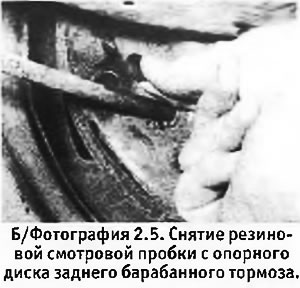2. If the brake system warning light on the dashboard lights up when the handbrake is off, check the brake fluid level immediately (see below). If the level is OK, check the adjustment of the handbrake warning light switch.
Every 7500 km or every six months
3. Thoroughly clean the area around the brake fluid reservoir cap, remove the cap and check the fluid level. Some tanks have transparent walls, and the liquid level can be checked without removing the plugs. If necessary, add fresh fluid to the tank, taking into account that its level will rise after replacing the plug with its switch and float. Check that the vent hole in the reservoir cap is not clogged. If it is necessary to add fluid frequently, it is necessary to inspect the brake system for leaks. It is normal for the level to drop slowly and slightly as the brake pads wear.
Every 15,000 km or once a year
4. Inspect for wear on the front disc brake pads (see section 8). Grooves should be visible on the pads, indicating that the friction layer has not been worn off.
5. Remove the rubber inspection plugs from the rear drum brake platters and inspect the brake pads for wear. If at least one pad is less than 2.5 mm thick, all 4 pads must be replaced (see photo).

6. Check the operation of the hand brake. When lifting the lever up 6-8 clicks, the rear wheels should be locked.
7. Check the gap between the fully depressed brake pedal and the floor to make sure the pedal is not touching the floor.
Every 30,000 km or every 2 years
8. Remove the rear brake drums and carefully clean them of dust, making sure not to inhale it. Inspect the brake linings for wear and check for oil or brake fluid contamination. If at least one lining is dirty or oily, all 4 brake pads must be replaced, but before that, the source of contamination must be found and eliminated (oiling).
Every 45,000 km or every 2 years
9. Change the brake fluid. Over time, its properties deteriorate, because. there is a destruction of additives that prevent corrosion and slow down the destruction of seals. In addition, the liquid absorbs moisture from the air (Therefore, fresh brake fluid must be stored in tightly sealed containers). Moisture in brake fluid lowers its boiling point and impairs freeze resistance. Brake fluid must always be changed at the specified intervals.
